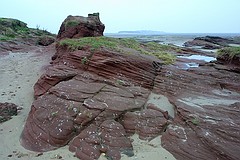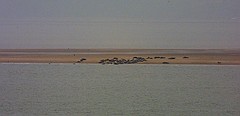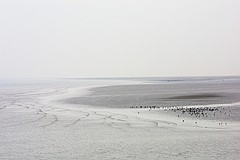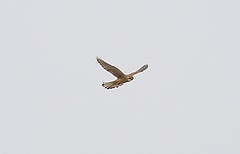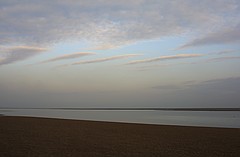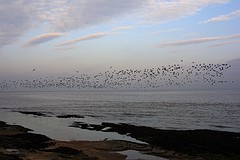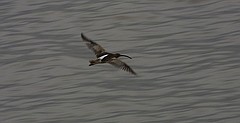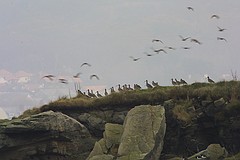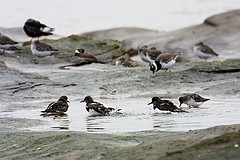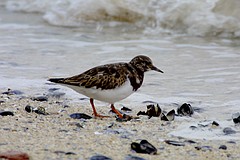Hilbre Island
October 30th 2002
I went back to Hilbre Island, for the first time in years, at low tide, walking across the sand which spread out around me in all directions.
Approaching the first island, Little Eye, the sand was dotted with the mounds and holes of lugworms, one of the species in the complex food chain of the Dee Estuary which sustains the huge numbers of birds which live there, and which retire to roosts which include the three islands of the Hilbre group during high tide.
The distinctive rocks of Little Eye, with the other islands in the distance. I have heard that this island was a favourite of Eric Hosking, the pioneering bird photographer. I have just bought a hide, and sometime soon I will spend a tide here.
I skirted the middle island, Little Hilbre, and walked across Hilbre Island itself, and became aware of a strange moaning coming from a distance. Looking towards the Welsh shore across the estuary, I saw the cause - a colony of grey seals hauled out on a sandbank called the West Hoylake bank. Through my binoculars, I thought that I could distinguish a couple of white spots among the seals, which could be this year's pups in their baby fur. If so, what happens to them when the tide comes in?
From the abandoned lifeguard station, I could see many oystercatchers on the sand, and as I walked around the rocky beach, others were working the mussel beds exposed along the water's edge.
A kestrel surveyed his island from the top of a flag pole for some time, but flew off to hover above the scrub along the top of the beach as I came near.
December 6th 2002
I walked quickly across the sands, because I was already late if I wanted to get to Hilbre before it was surrounded by water. As I came up to Little Hilbre, the gutter running along the landward side was already filling with water, and as I came around the corner of the island, I found that a huge flock of oystercatchers were resting in the gap. They took off at the sight of me and I hurried across, filling my wellingtons as I waded the last bit across the incoming tide.
After wringing out my socks and draining the wellingtons, I walked across the island, which only held a few birds here and there. The kestrel was there again, hovering over the scrub above the eastern beach, and a curlew took off before I saw it, shouting its name as it flew away. At the far end, I sat on the bare rocks, drinking coffee from my thermos flask, watched by a grey seal at intervals during his fishing.
I walked back and settled down where I could look across at Little Hilbre, which was covered with birds. On the left of the grassy top, a flock of curlew kept to themselves, surrounded by vast numbers of oystercatchers. Amongst the oystercatchers on the rocks were a group of gulls and a single heron, while on the grassy top, a few crows roosted, amusing themselves by occasionally bullying the waders around them. On a small cliff face further to the right clung a flock of dunlin.
In front of me, a small mixed flock of waders (dunlin, sanderling, knot, oystercatcher, ringed plover and turnstone) were roosting, slowly retreating before the advancing tide.
The tide turned, and as the water receded, some of the resting birds began preparing for action on the sandflats of the estuary. Some preened their plumage, while others bathed in shallow pools on the rocks. Turnstones were quickly into action, investigating mussel shells along the water's edge.
As more and more rocks were exposed by the retreating water, birds left to go about their business. Some left singly, others in small groups. The oystercatchers seemed reluctant to leave, but spread out as more space became available. When at last, some large groups flew off, I began to make my way across the gap from Hilbre, and the oystercatchers took off en masse.
The ripples in the sand were still filled with water as I splashed back to West Kirby, rejoining the rest of the human race after a whole day as one of those special people - an islander.
January 5th 2003
Little Eye in a hide for a tide - click here for an account, with pictures, of a wonderful day.
All text and graphics © Pat Bennett 1996-2002

